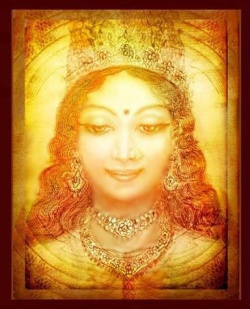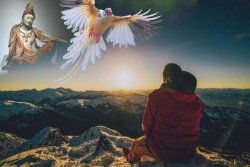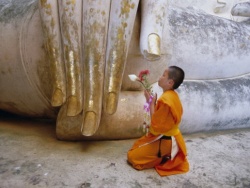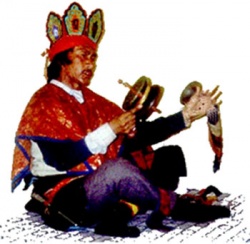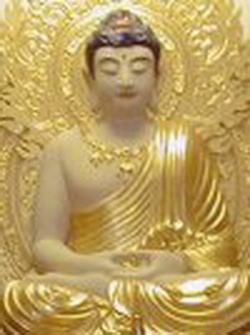Oothu Chikitsa
Oothu Chikitsa
(Blowing Therapy)
A survey reports “It is difficult to provide comprehensive primary health care to entire population in developing countries like India where 70% of the population live in rural areas.
One of the most certain and feasible ways to provide to reach the entire population by strengthening and taking the support and help of traditional medicine and its practitioners in cultures world wide.”
Agadatantra, an Ayurveda science deals with the management of poisoning from various sources.
It is not a deniable fact that incidence of snake bite has not declined in rural areas and at the same time statistics proves that suburban areas are also vulnerable to snake bite.
It means treatment of snake bite cases still remains a challenge to the medical fraternity even after invention of sophisticated and advanced medicines and techniques.
The contribution of professional vishavaidyas from Kerala for the management of snake bite is highly appreciated.
The ayurvedic treatment module for this medical emergency is unique and requires medical skills and experience to practice.
Apart, from using treatment mentioned in Samhita, they follow many unique treatments which are known to local vishavaidyas, since ages.
All these treatments are mentioned in Malayalam Visha text book and are passed from generation to generation in the family of vishavaidyas.
Many Vishavaidyans families in Kerala are practicing Oothu chikitsa such as Vimalaantarajanam of ollur mana, Thrissur.
There are many medicines and treatments which are effectively used as life saving tools in the remote areas.
Oothu is one among them which is used in snake bite cases when the patient is falling unconscious.
It is an emergency treatment which is very handy and can be practiced with minimal requirement.
The treatment modality called oothu is one of the most important therapeutic procedures performed in the initial stage of snake bite treatment, particularly in the stages of vata, kapha or vatakapha predominances and when the effect of visha is limited to the first three dhatus.
The textual reference for this method of treatment is jyotsnika.
Indications: A vishavaidyas mainly employs this treatment modality when any or all of the following symptoms appears in a snakebite victim
1. Delay in responses to verbal and physical stimuli
2. Drowsiness
3. Drooping of the eyes
4. Numbness over the tongue, mouth and scalp 5. Pain all over the body
6. Paralysis of jaw, tongue, larynx and neck 7. Headache
8. Dizziness, vertigo
9. Excess salivation, formation of mucous and fluids in the chest, eyes etc.
Materials required: The drugs required are Sunthi(dried rhizome of Zingiber officinale), Dusparsha( root of Tragia involucrata), Maricha(dried fruits of Piper nigrum),Iswaramuli(root of Aristolochia indica).
In common practice the root of dusparsha is generally avoided, partly due to the difficulty in procuring the drug at short notice and partly due to allergic reaction it produces in certain individuals.
Method: Three persons who have not consumed alcohol or any such tiksna dravyas(because such dravyas being similar in nature to that of visha can aggravate it further) for the last 24 hours are needed for the treatment.
If the persons have chewed tobacco or betel leaves, they should thoroughly wash their mouth before starting the treatment.
The patient should be seated in a comfortable position, either in a chair or a high pedestal, which is convenient for the treatment. One attendant should stand behind and the other two attendants on either sides of the patient.
They should then chew a small quantity of the 4 drugs explained above, slightly pounded together.
The person standing behind the patient should blow air through his mouth onto the murddha of the patient and the two attendants standing on either side should blow air through their mouth to the ear on the respective side.
This should be done synchronously for at least 150 times. It can be increased as per the patient’s condition.
The attendants can briefly stop the treatment in between to spit out excess saliva. Care should be taken not to spit out the medicines kept in the mouth.
Improvements can be noticed in the responses of the patient after 75-100 blowing.
After 150 blowing there is usually a marked improvement in the verbal and physical responses, drowsiness and drooping of the eyes.
The patients report a vivid feeling of the effects of visha descending down their body before disappearing.
All these medicines and procedures fulfill the criteria of the plans of the AYUSH which aims to popularize local health tradition which is immediate /handy and also cost-effective treatment.
But, the effort should be put to prove the efficacy, mode of action of these procedures and anti-dotes on the scientific basis to be accepted largely by the Ayurvedic medical community.
Such efforts will help the survival of the very precious and rarest procedures and anti-dotes to come to mainstream which would be beneficial for the mankind.
